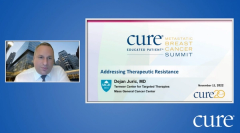
Educated Patient® Metastatic Breast Cancer Summit Overview of Management of Hormone Receptor-positive Breast Cancer: Third Line and Beyond Presentation: November 12, 2022
Watch Dr. Laura M. Spring, from Massachusetts General Hospital in Boston, discuss treatment in third line and beyond for hormone receptor-positive breast cancer, during the CURE® Educated Patient® Metastatic Breast Cancer Summit.
A common misunderstanding about clinical trials in cancer research, according to an expert, is that patient participation is only reserved for those who have already received other treatments that have all stopped working at some point. s
Instead, as Dr. Laura M. Spring recently explained, clinical trials should be considered even if a patient with cancer has not yet been previously treated.
“There’s some misconception that we move to clinical trials when we don’t have anything good left,” Spring, an assistant professor of medicine at Harvard Medical School and a breast medical oncologist at Massachusetts General Hospital Cancer Center in Boston, said during CURE®’s Educated Patient® Metastatic Breast Cancer Summit.
“I really want to emphasize that is not the case,” she said. “We’re always trying to improve treatment at every step. Even in the first- and second-line setting, it’s important to think about clinical trials.”
Spring joined a group of panelists recently and discussed the third-line treatment options that are available for patients with hormone receptor-positive breast cancer.
Starting With the Second Line
Although Spring was highlighting treatment options available to patients whose tumor or tumors failed to respond to at least two prior therapies, she noted that there is still a use for second-line treatments.
The reason, she said, is because there are several options already available that can possibly be used if a patient’s hormone receptor-positive disease did not respond to the treatment.
“If you don’t use one of those (second-line options) in the second line, then of course it is something you revisit and think about in the third line and beyond,” she said.
How to Determine What to Use
When it comes to selecting a third-line treatment option, several factors come into play, according to Spring.
For instance, has the disease stopped responding to endocrine therapy? Depending on the answer, Spring noted that they can continue to block estrogen receptors with a combination of targeted therapy. Or possibly, Spring said, the disease has mutated, and oncologists need to take a broader approach.
And that’s why Spring said she recommends tumor sequencing at all times during a patient’s cancer journey.
“That’s where genomic testing can be very helpful to show you what the tumor is looking like right now,” she said. “That sequencing may have been performed upfront, but it's important to think about repeating it at certain intervals because this disease we know evolves with time. … We want to also think, does this tumor have any features that may suggest other treatment options?”
Introducing HER2-Low Breast Cancer
A recent development that altered the breast cancer landscape was the findings of the DESTINY-Breast04 clinical trial, according to Spring.
She explained that the data demonstrated that treatment with Enhertu (fam-trastuzumab deruxtecan-nxki)
Shortly after the findings were presented, the
“And so now with this new option available to us, this is one approach to thinking about the treatment of this disease, when a patient does have HER2-low (metastatic breast cancer),” she said.
For more news on cancer updates, research and education, don’t forget to













